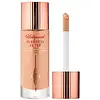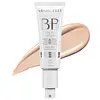What's inside
What's inside
 Key Ingredients
Key Ingredients

 Benefits
Benefits

 Concerns
Concerns

 Ingredients Side-by-side
Ingredients Side-by-side

Water
Skin ConditioningHydrogenated Didecene
Skin ConditioningMica
Cosmetic ColorantGlycerin
HumectantPropanediol
SolventSqualane
EmollientCetyl PEG/PPG-10/1 Dimethicone
EmulsifyingIsoamyl Laurate
EmollientHydrogenated Styrene/Isoprene Copolymer
Sodium Chloride
MaskingCaprylic/Capric Triglyceride
MaskingHydroxyacetophenone
AntioxidantPolyglyceryl-4 Isostearate
Emulsifying1,2-Hexanediol
Skin ConditioningCaprylyl Glycol
EmollientTrisodium Ethylenediamine Disuccinate
Hoya Lacunosa Flower Extract
Skin ConditioningPentaerythrityl Tetra-Di-T-Butyl Hydroxyhydrocinnamate
AntioxidantCI 77891
Cosmetic ColorantIron Oxides
CI 77163
Cosmetic ColorantWater, Hydrogenated Didecene, Mica, Glycerin, Propanediol, Squalane, Cetyl PEG/PPG-10/1 Dimethicone, Isoamyl Laurate, Hydrogenated Styrene/Isoprene Copolymer, Sodium Chloride, Caprylic/Capric Triglyceride, Hydroxyacetophenone, Polyglyceryl-4 Isostearate, 1,2-Hexanediol, Caprylyl Glycol, Trisodium Ethylenediamine Disuccinate, Hoya Lacunosa Flower Extract, Pentaerythrityl Tetra-Di-T-Butyl Hydroxyhydrocinnamate, CI 77891, Iron Oxides, CI 77163
Water
Skin ConditioningCyclopentasiloxane
EmollientOctyldodecanol
EmollientGlycerin
HumectantDimethicone/Vinyl Dimethicone Crosspolymer
Skin ConditioningDimethicone
EmollientCyclohexasiloxane
EmollientPropylene Glycol
HumectantIsopropyl Myristate
EmollientBis-PEG/PPG-14/14 Dimethicone
EmollientMica
Cosmetic ColorantAluminum Starch Octenylsuccinate
AbsorbentHexyl Laurate
EmollientCetyl PEG/PPG-10/1 Dimethicone
EmulsifyingPolyglyceryl-4 Isostearate
EmulsifyingSilica
AbrasiveXylitylglucoside
HumectantDimethicone Crosspolymer
Emulsion StabilisingSodium Chloride
MaskingAnhydroxylitol
HumectantDisteardimonium Hectorite
StabilisingIsododecane
EmollientXylitol
HumectantTrihydroxystearin
Skin ConditioningAcrylates/Dimethicone Copolymer
Skin ConditioningPropylene Carbonate
SolventTocopheryl Acetate
AntioxidantHydrolyzed Hyaluronic Acid
HumectantButylene Glycol
HumectantTriethoxycaprylylsilane
Camellia Oleifera Leaf Extract
AstringentLauroyl Lysine
Skin ConditioningAloe Barbadensis Leaf Juice
Skin ConditioningChlorphenesin
AntimicrobialIsoceteth-10
EmulsifyingGlucose
HumectantMyristic Acid
CleansingCitric Acid
BufferingPotassium Sorbate
PreservativePhenoxyethanol
PreservativeSodium Benzoate
MaskingCI 77891
Cosmetic ColorantCI 77492
Cosmetic ColorantCI 77491
Cosmetic ColorantCI 77499
Cosmetic ColorantWater, Cyclopentasiloxane, Octyldodecanol, Glycerin, Dimethicone/Vinyl Dimethicone Crosspolymer, Dimethicone, Cyclohexasiloxane, Propylene Glycol, Isopropyl Myristate, Bis-PEG/PPG-14/14 Dimethicone, Mica, Aluminum Starch Octenylsuccinate, Hexyl Laurate, Cetyl PEG/PPG-10/1 Dimethicone, Polyglyceryl-4 Isostearate, Silica, Xylitylglucoside, Dimethicone Crosspolymer, Sodium Chloride, Anhydroxylitol, Disteardimonium Hectorite, Isododecane, Xylitol, Trihydroxystearin, Acrylates/Dimethicone Copolymer, Propylene Carbonate, Tocopheryl Acetate, Hydrolyzed Hyaluronic Acid, Butylene Glycol, Triethoxycaprylylsilane, Camellia Oleifera Leaf Extract, Lauroyl Lysine, Aloe Barbadensis Leaf Juice, Chlorphenesin, Isoceteth-10, Glucose, Myristic Acid, Citric Acid, Potassium Sorbate, Phenoxyethanol, Sodium Benzoate, CI 77891, CI 77492, CI 77491, CI 77499
 Reviews
Reviews

Ingredients Explained
These ingredients are found in both products.
Ingredients higher up in an ingredient list are typically present in a larger amount.
This ingredient is a high molecular weight silicone. It has emulsifying and skin conditioning properties.
Ci 77891 is a white pigment from Titanium dioxide. It is naturally found in minerals such as rutile and ilmenite.
It's main function is to add a white color to cosmetics. It can also be mixed with other colors to create different shades.
Ci 77891 is commonly found in sunscreens due to its ability to block UV rays.
Learn more about CI 77891Glycerin is already naturally found in your skin. It helps moisturize and protect your skin.
A study from 2016 found glycerin to be more effective as a humectant than AHAs and hyaluronic acid.
As a humectant, it helps the skin stay hydrated by pulling moisture to your skin. The low molecular weight of glycerin allows it to pull moisture into the deeper layers of your skin.
Hydrated skin improves your skin barrier; Your skin barrier helps protect against irritants and bacteria.
Glycerin has also been found to have antimicrobial and antiviral properties. Due to these properties, glycerin is often used in wound and burn treatments.
In cosmetics, glycerin is usually derived from plants such as soybean or palm. However, it can also be sourced from animals, such as tallow or animal fat.
This ingredient is organic, colorless, odorless, and non-toxic.
Glycerin is the name for this ingredient in American English. British English uses Glycerol/Glycerine.
Learn more about GlycerinMica is a naturally occurring mineral used to add shimmer and color in cosmetics. It can also help improve the texture of a product or give it an opaque, white/silver color.
Serecite is the name for very fine but ragged grains of mica.
This ingredient is often coated with metal oxides like titanium dioxide. Trace amounts of heavy metals may be found in mica, but these metals are not harmful in our personal products.
Mica has been used since prehistoric times throughout the world. Ancient Egyptian, Indian, Greek, Roman, Aztec, and Chinese civilizations have used mica.
Learn more about MicaThis ingredient is an emulsifer and stabilizer. It comes from isostearic acid and polyglycerin.
As an emulsifier, it helps blend oil and water to improve texture, spreadbility, and application.
Due to it being derived from isostearic acid, this ingredient may not be fungal acne safe.
Learn more about Polyglyceryl-4 IsostearateChances are, you eat sodium chloride every day. Sodium Chloride is also known as table salt.
This ingredient has many purposes in skincare: thickener, emulsifier, and exfoliator.
You'll most likely find this ingredient in cleansers where it is used to create a gel-like texture. As an emulsifier, it also prevents ingredients from separating.
There is much debate on whether this ingredient is comedogenic. The short answer - comedogenic ratings don't tell the whole story. Learn more about comegodenic ratings here.
The concensus about this ingredient causing acne seems to be divided. Research is needed to understand if this ingredient does cause acne.
Scrubs may use salt as the primary exfoliating ingredient.
Learn more about Sodium ChlorideWater. It's the most common cosmetic ingredient of all. You'll usually see it at the top of ingredient lists, meaning that it makes up the largest part of the product.
So why is it so popular? Water most often acts as a solvent - this means that it helps dissolve other ingredients into the formulation.
You'll also recognize water as that liquid we all need to stay alive. If you see this, drink a glass of water. Stay hydrated!
Learn more about Water